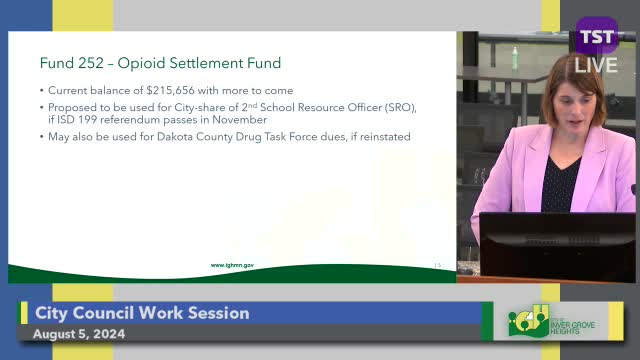City plans to use opioid settlement funds for school safety
August 05, 2024 | Inver Grove Heights, Dakota County, Minnesota

This article was created by AI summarizing key points discussed. AI makes mistakes, so for full details and context, please refer to the video of the full meeting. Please report any errors so we can fix them. Report an error »

During a recent government meeting, officials discussed the allocation of funds from opioid settlements and other financial resources aimed at addressing community needs. The city has received $215,656 from settlements with major opioid manufacturers, with projections suggesting total receipts could reach up to $1 million over the coming years. The funds are intended for various uses, with two primary proposals on the table: funding a second school resource officer and supporting the Dakota County Drug Task Force.
The proposed school resource officer would primarily serve middle and high school students, addressing increasing substance use among younger populations. The city plans to cover its share of the officer's salary through the opioid settlement funds, contingent on the approval of a referendum by School District 199.
Additionally, discussions included the potential use of American Rescue Plan Act (ARPA) funds for affordable housing initiatives. Council members expressed interest in subsidizing interest rates for home rehabilitation loans, which could alleviate financial burdens for residents facing inflation. However, clarity is needed on whether transferring these funds to another governmental entity would count as a committed expenditure.
Another significant topic was the city's southeast quadrant Tax Increment Financing (TIF) district, which has a balance of approximately $4.1 million. Officials outlined two eligible uses for these funds: supporting affordable rental housing projects or returning the money to Dakota County for redistribution among local taxing jurisdictions. The council is considering how best to utilize these funds, with suggestions including subsidizing development fees for affordable housing projects or investing in parkland acquisition.
The meeting concluded with a discussion on a one-time public safety aid fund, created from a refund received from Dakota 911. This fund aims to address the need for expensive public safety equipment not covered by existing budgets.
Overall, the meeting highlighted the city's proactive approach to utilizing various funding sources to enhance community safety, support education, and address housing needs, while also navigating the complexities of fund allocation and community priorities.
The proposed school resource officer would primarily serve middle and high school students, addressing increasing substance use among younger populations. The city plans to cover its share of the officer's salary through the opioid settlement funds, contingent on the approval of a referendum by School District 199.
Additionally, discussions included the potential use of American Rescue Plan Act (ARPA) funds for affordable housing initiatives. Council members expressed interest in subsidizing interest rates for home rehabilitation loans, which could alleviate financial burdens for residents facing inflation. However, clarity is needed on whether transferring these funds to another governmental entity would count as a committed expenditure.
Another significant topic was the city's southeast quadrant Tax Increment Financing (TIF) district, which has a balance of approximately $4.1 million. Officials outlined two eligible uses for these funds: supporting affordable rental housing projects or returning the money to Dakota County for redistribution among local taxing jurisdictions. The council is considering how best to utilize these funds, with suggestions including subsidizing development fees for affordable housing projects or investing in parkland acquisition.
The meeting concluded with a discussion on a one-time public safety aid fund, created from a refund received from Dakota 911. This fund aims to address the need for expensive public safety equipment not covered by existing budgets.
Overall, the meeting highlighted the city's proactive approach to utilizing various funding sources to enhance community safety, support education, and address housing needs, while also navigating the complexities of fund allocation and community priorities.
View full meeting
This article is based on a recent meeting—watch the full video and explore the complete transcript for deeper insights into the discussion.
View full meeting
